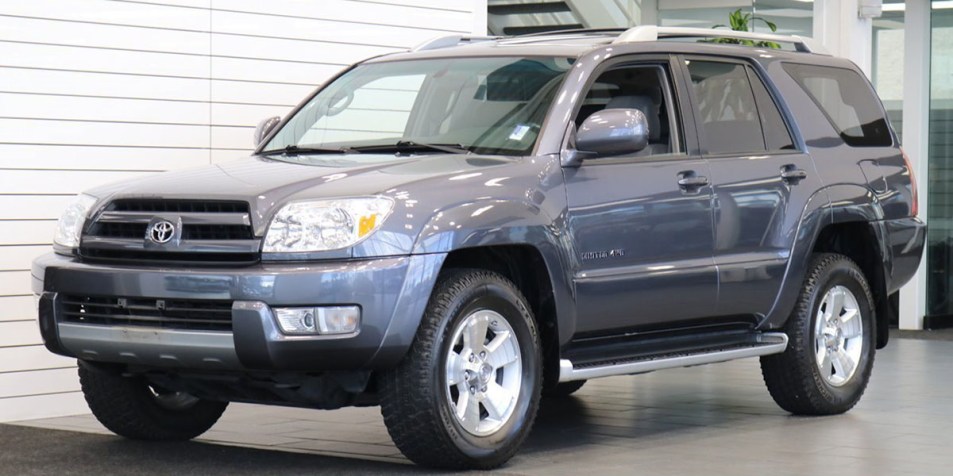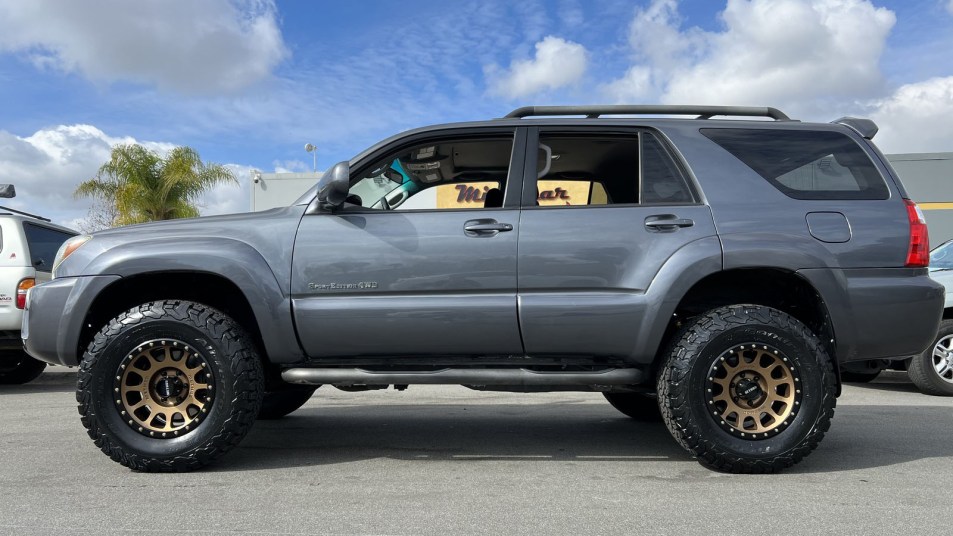If any Toyota 4Runner seems to fly under the radar, it is the 2003 – 2009 fourth-generation model. These SUVs were not loved when new, but they are a great value on the used market — especially compared to their predecessors.
As the follow-up to the muscularly-styled, but sized just-right third-gen, the fourth 4Runner had big tires fill. It got off to a rough start thanks to bulbous styling punctuated by enormous unpainted fender flares on mainstream SR5 models. Toyota was quick to address this, though, and by the end of its run, the 4Runner was back at the top of its game.
The 2003 4Runner marked a major departure from its predecessor. Considerably larger both inside and out, it made use of new V6 and V8 engine options with far more power than before. The base V6 put out 245 horsepower and 283 lb-ft of torque, while the 4.7-liter V8 cribbed from the Lexus lineup was rated at 235 hp and 320 lb-ft of torque.
Inside, the 4Runner had far more room than before. The cargo areas were especially roomy and could be had with a double-decker shelf that stretched between the wheel arches to create a two-tier trunk. Additional neat touches inside, depending on the trim, included convex mirrors mounted to the D-pillars to improve over-the-shoulder visibility and way more features than before such as the option to add side-impact airbags and a navigation system.
The initial lineup consisted of SR5, Sport, and Limited trim levels, and the middle trim somewhat lived up to its name thanks to the X-REAS suspension featuring hydraulic links between opposite corners designed to counter body lean in hard cornering. While hardly enough to turn the 4Runner into a Porsche Cayenne, the system worked well when new and helped differentiate the 4Runner from its predecessors.
Rear-wheel drive was standard. A part-time 4-wheel-drive system with an automatic mode for use on dry pavement came with the V6, while V8s used a full-time setup. Stability and traction control were standard on all.
Underneath, the 4Runner was identical to the Lexus GX 470 — a hugely popular choice among overlanders, or at least those who want to look the part.
Though the added heft meant that some of the zippiness inherent to the prior 4Runner had been dialed out, the fourth-generation models have a comfortable, composed ride and a more stable feel on the highway. The optional V8 is particularly well-mated to its 5-speed automatic transmission, too.
In typical Toyota fashion, the lineup never saw a major redesign until the 4Runner was replaced in 2010. Updates included:
- 2004: A small third-row seat is added to the options list and all models gain a tire-pressure warning system. The unpainted fender flares and bumpers are dropped.
- 2005: A five-speed automatic transmission for the V6 and more power (270 hp) for the V8.
- 2006: Head- and taillights as well as the side cladding are revamped for the closest thing this vehicle got to a mid-cycle update.
- 2008: Side airbags are now standard, while an Urban Runner package with the X-REAS suspension and a downright bizarre audio head unit with a removable TomTom navigation system is added.
- 2009: A Trail Edition package for the SR5 includes a locking rear differential and Bilstein shocks, plus the TomTom navigation head unit.
Finding a Fourth-Gen 4Runner Today
The fourth-generation 4Runner was never the sales hit of its predecessor. In 2004, its best year, the 4Runner found 114,212 homes in the US, but demand tumbled to just 48,000 in 2008 and fewer than 20,000 in 2009, the 4Runner’s worst year since 1987. If anything, it was something of a shock that Toyota saw fit to reboot the 4Runner for 2010 — though strong demand the last few years has kept this SUV a rare sight on new-car lots.
Still, these are Toyota SUVs, and they tend to hold up well over time. The pick of the litter for most shoppers is something with a V8 engine, preferably one after the mild 2006 update.
Prices for third-generation 4Runners have gone through the roof over the last few years, making their successors seem like bargains by comparison. For instance, here’s a pristine 2004 Limited with the V6 that shows just 59,700 miles for a whopping $38,997 at a dealership in Portland, Oregon. About 8 grand less also buys a 2007 Sport with double the miles at this California dealer.
Those final-year Trail models are tricky to find — there are currently 0 available on Autotrader — but they are well worth the search when one is available.
V8-powered 4Runner examples are in somewhat shorter supply. Gas prices were on the rise for much of the time they were offered, so shoppers tended to favor the slightly more frugal V6. If that’s not a big deal for you, something like this clean V8-powered 2007 4Runner Sport with 126,000 miles at a dealer in San Diego for $30,995 seems like a decent value.













My ‘03 4.7 bought off the showroom floor 22yrs ago is still gettin it without a hitch.
I have just inherited a 2003 4 runner with 63k miles. V8 and excellent condition. Should last me the rest if my life.
Nice, you always give examples V8-powered 4Runner examples are in somewhat shorter supply
Oh my god! this car is super sweet for offraods
Holy crap! 30k for a 2007 4runner, they really do hold their value!